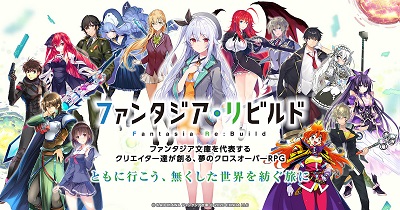Fantasia Re:Build (2020)
[ファンタジア・リビルド]

Note: Service for this game has been discontinued as of December 2021.
Publisher: Kadokawa, EXNOA
Developer: gumi
Platform: Android/iOS/PC
Overview:
A high school student and an amnesiac girl find themselves on an adventure through the multiverse to put a stop to the collapse of reality.
Gameplay:
The core gameplay is that of a turn-based RPG where you have three active party members (two of your characters plus a support character from other uses) and four reserve members. Your party is displayed on a tape you can shift between turns. You can't swap position freely, so some care may be needed to have your reserves where you want them if they need to be deployed.
Characters come in eight classes (Braver, Strider, Mystic, Crusher, Shooter, Trickster, Penetrator, and Variable), each with their own affinities and weaknesses. (There are a few characters that have their own classes outside the main system, such as Ende.) You don't have to worry about memorizing the system as the game helpfully points you to which classes have the advantage in the mission select menu. Besides your basic attacks, you have a special attack that you can deploy when your meter builds to 100%, a rotation skill that activates when a reserve character is cycled to the front line, and active/support skills that can provide buffs and such. You also have passive skills that provide assorted perks. You can either battle manually or run on auto. You rarely encounter a scenario where auto-battling isn't effective. You also have items called Fragments that can be equipped for various stat boosts, but these will add to the deployment cost of your party. Your max cost is determined by your level, so don't think you can send six 5-star character with 5-star Fragments from the start.
Both character level and their skill levels are raised via items (with the exception of the special attack, which is boosted as you draw multiple copies of a given character). Fragment level is boosted by consuming other Fragments (with level caps being broken up to four times by merging with copies of the same Fragment). When a character reaches their level cap, you can expend select items in the Rebuild menu (up to four times) and then perform an EX Rebuild when they've hit their Rebuilded max.
As with pretty much all Japanese mobile games, this one has a gacha system. Your primary currency is Fantasy Stones, which come in both free and premium varieties. Some banners only take premium Fantasy Stones. The drop rate isn't too bad, though. You'll at least get a 4-star Fragment if not a 4-star character on a 10-draw. Besides the Fantasy Stones, you also have Friend Medals for lower-level pulls. Then there are of course numerous other tokens that can be exchanged in the Shop, along with premium purchases.
Besides the main story quests, you also have limited time event quests and farming quests for assorted materials. There is also a dispatch section where you can send characters to farm while raising their experience and intimacy levels (and this doesn't leave them unavailable for deployment like most other games with a similar feature).
Story/Characters:
This game was made to celebrate the 30th anniversary of Fujimi Fantasia Bunko and the Monthly Dragon Magazine. We have a workable premise to justify the crossover of all these different properties with worlds collapsing and merging across the multiverse. Normally, the player insert protagonist won't have much going on, but you get some amusing dialog options and the banter with your partner Ende is one of the things I enjoy most about the game. If you're a fan of the different franchises, there's a lot of fun to be had in their interactions. Most of the fun is how the mesh and clash with each other. The story overall isn't too heavy and the comedy works rather well. Perhaps my only criticism is that the story segments before each mission tend to run on a little long for a mobile game intended to be consumed in small doses.
Besides the main story and event stories, there are also character episodes that are unlocked as you raise your intimacy level.
Graphics:
The general interface has a slick feel to it, as befits your home base the Auriculaire. With the exception of event variants, character art is from the original illustrators, so there isn't a unified aesthetic, but this isn't so unusual in mobile games like this. Battle sprites do have a unified look to them, though, and they don't have the puppet-like animations of some other games like Cryptract or Sinoalice. Special attack animations are fairly elaborate.
Character art and battle sprites get update on the second and fourth Rebuild, so that's something to look forward to.
Music/Sound:
The music, while nothing amazing, does its job well. The main menu theme is nice and chill. Whenever possible, all the original seiyuu for the characters are used. The story isn't full-voice, but the characters have quite a few lines when they appear on the main menu screen. Their commentary tends to be rather amusing. They also have different battle lines when paired with certain characters, especially those from their own franchises.
Conclusion:
This is a fairly standard mobile JRPG that banks on the strength of all the franchises it has access to. I'd argue that it's something of a gateway drug from Kadokawa to get you hooked on the featured franchises. However, it's also a fine treat for existing fans that want to play around with their favorite characters. It's definitely worth trying out at the very least.
Rating:
Play It
